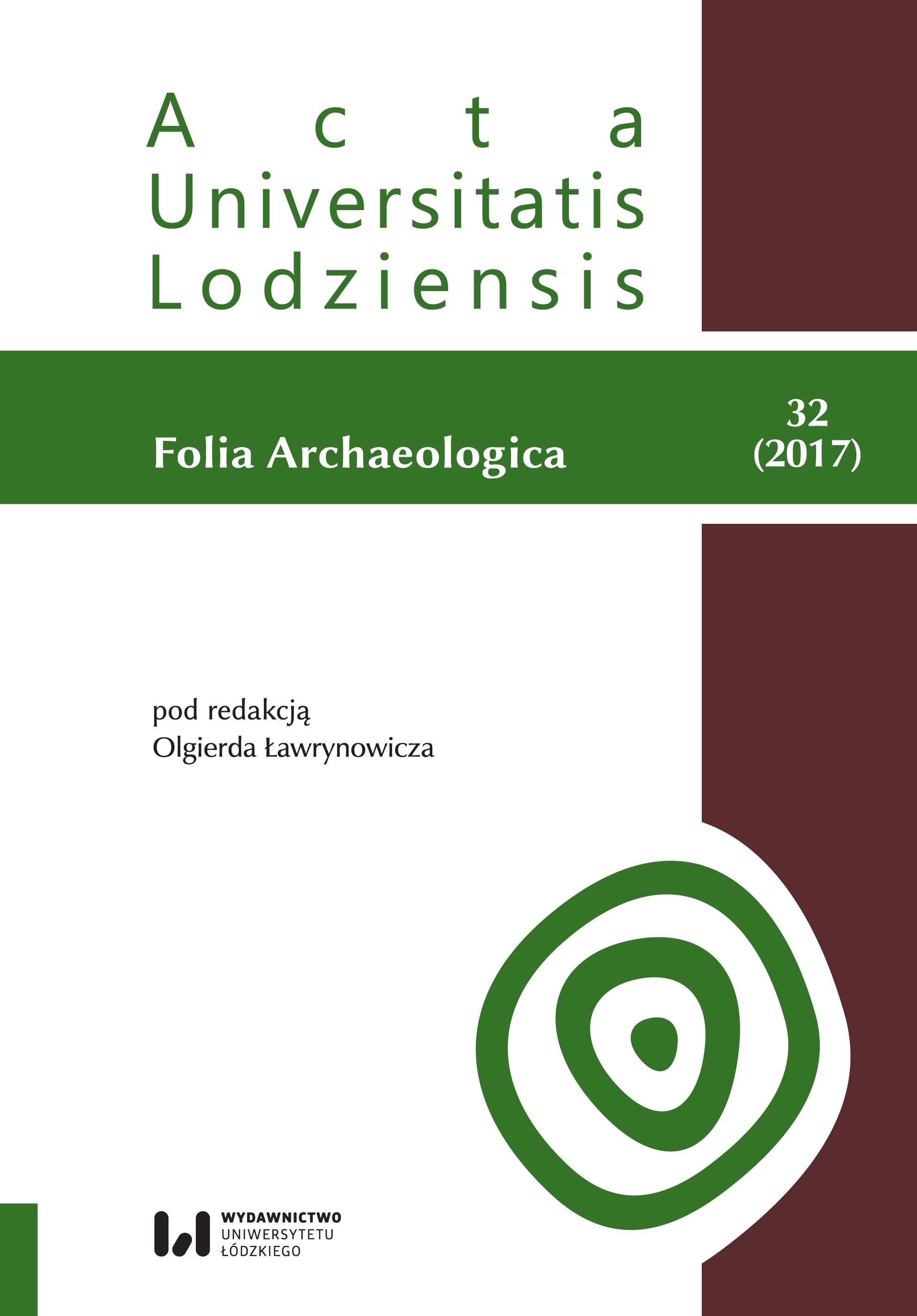Duchy miejsca – napisy (graffiti) w przestrzeniach publicznych i prywatnych jako przedmiot badań archeologii współczesnej przeszłości
DOI:
https://doi.org/10.18778/0208-6034.32.14Słowa kluczowe:
napisy, ryty, graffiti, archeologia niedawnej (współczesnej) przeszłości, pamięćAbstrakt
Writing, signing and carving names in public spaces are popular ways of indicating somebody’s presence in the world. Various inscriptions made in different places have been appearing from the ancient times until today. There are multiple motivations for such practice: a simple signing to indicate somebody’s presence, a declaration of sympathy or antipathy to some idea or person or political manifests and encouragement to engage in some actions. Despite the popularity of such phenomenon and its long duration, archaeologists, especially those involved in studying the recent or contemporary past, are not particularly focused on researching this source of knowledge. Most of the academic works which concern inscriptions and graffiti are conducted by sociologists or visual culture specialists. However, these sources may be truly significant in studying microhistories of the places and people. Thus, in our article we want to present a unique potential of graffiti in the studies related to the recent and contemporary past.
The aim of our article is to show various spatial contexts in which graffiti may be encountered and to present how the archaeology of the contemporary past may take advantage of researching such inscriptions. After Laurent Olivier (2001), we think that discovering the local past is a characteristic feature of the archaeology of the contemporary past and our article aims to show how the specific “being” of graffiti around us may contribute to discovering the microhistories of people and places.
According to Michael Bell’s concept (1997), we interpret graffiti as “the ghosts of place” which indicate the presence of those who are no longer in the place. Due to the breadth of topics connected with graffiti, we decided to focus on those inscriptions which manifest someone’s presence in the place, narrowing our studies only to its written form (not graphic).
Pobrania
Bibliografia
Aleksijewicz S. (2015), Cynkowi chłopcy, Czarne, Wołowiec.
Google Scholar
Baird J.A., Taylor C. (red.) (2010), Ancient graffiti in context, Routledge, London.
Google Scholar
Bell M. (1997), The Ghosts of Place, „Theory and Society”, t. 26, s. 813–836.
Google Scholar
Bystroń J. (1980), Tematy, które mi odradzano. Pisma etnograficzne rozproszone, oprac. L. Stomma, PIW, Warszawa.
Google Scholar
Cyra A. (2006), Pozostał po nich ślad…, Państwowe Muzeum Auschwitz-Birkenau, Oświęcim.
Google Scholar
Drozdowski R. (2007), Obraza na obrazy. Strategie społecznego oporu wobec obrazów dominujących, Zysk i S-ka, Poznań.
Google Scholar
Frąckowiak M. (2009), Historia na drzewach zapisana. Przyczynek do poznania dziejów MRU na podstawie napisów zachowanych na bukach w pobliżu Chyciny, [w:] B. Mykietów, M. Tureczek (red.), Ziemia Międzyrzecka w przeszłości, t. 7, Muzeum w Międzyrzeczu, Międzyrzecz, s. 143–150.
Google Scholar
Frederick U.K. (2009), Revolution is the new black: graffiti/art and mark-making practices, „Archaeologies”, t. 5(2), s. 210–227.
Google Scholar
Graves-Brown P., Schofield J. (2011), The filth and the fury: 6 Denmark Street (London) and the Sex Pistols, „Antiquity”, t. 85(330), s. 1385–1401.
Google Scholar
Kobiałka D., Frąckowiak M., Kajda K. (2015), Tree memories of the Second World War: a case study of common beeches from Chycina, Poland, „Antiquity”, t. 89(345), s. 683–696.
Google Scholar
Merril S.O.C., Hack H. (2013), Exploring hidden narratives: conscript graffiti at the former military base ‘Kummersdorf’, „Journal of Social Archaeology”, t. 13(1), s. 101–21.
Google Scholar
Olivier L. (2001), The archaeology of the contemporary past, [w:] V. Buchli, G. Lucas (red.), Archaeologies of the contemporary past, Routledge, London, s. 175–188.
Google Scholar
Oliver J., Neal T. (2010), Elbow grease and time to spare: the place of tree carving, [w:] J. Oliver, T. Neal (red.), Wild Signs: Graffiti in Archaeology and History (.
Google Scholar
BAR International Series), Oxford , s. 15–22.
Google Scholar
Osika G. (2008), Grafitti – znaki miasta, „Zeszyty Naukowe Politechniki Śląskiej” t. 43, s. 125–146.
Google Scholar
Ouzman S. (2010), Graffiti as art(e)fact: a contemporary archaeology. Wykład wygłoszony podczas University of Johannesburg Sociology, Anthropology and Development Seminar, Johannesburg, 10 marca 2010, https://www.uj.ac.za/faculties/humanities/sociology/Seminars/2010/Ouzman%202010%20Graffiti.pdf (dostęp: 4.11.2016).
Google Scholar
Pietkiewicz A. (2011), Street art – komunikacja masowego rażenia. Szkice o graffiti, stencilach i stickerach, „Ikonosfera. Studia z socjologii i antropologii obrazu”, t. 3, s. 63, http://www.ikonosfera.umk.pl/fileadmin/pliki/Ikonosfera_3_Aleksander_Pietkiewicz_Street_art.pdf (dostęp: 10.11.2016).
Google Scholar
Ralph J. (2014), Graffiti Archaeology, [w:] C. Smith (red.), Encyclopedia of Global Archaeology, Springer, New York, s. 3102–3107.
Google Scholar
Rosadziński L. (2014), Poszukiwacz, czyli niezwykli ludzie i stare książki, Rosa Dom Różności, Poznań.
Google Scholar
Rowiński R. (1968), Południk 15. Reportaże, Wydawnictwo Poznańskie, Poznań, s. 5–11.
Google Scholar
Rybchinsky Y. (2006), Photoestafeta from Rodchenko to our days. Pages of history of Soviet and contemporary Russian photography, Moskiewski Dom Fotografii, Moskwa.
Google Scholar
Sienkiewicz H. (2000), Listy z podróży do Ameryki, Most, Warszawa.
Google Scholar
Straszyńska A. (2015), Strzelecka 8, „Odkrywca”, t. 11(202), s. 26–31.
Google Scholar
Straszyńska A. (2016), Willa Jasny Dom, „Odkrywca”, t. 4(207), s. 30–35.
Google Scholar
Pobrania
Opublikowane
Jak cytować
Numer
Dział
Licencja

Utwór dostępny jest na licencji Creative Commons Uznanie autorstwa – Użycie niekomercyjne – Bez utworów zależnych 4.0 Międzynarodowe.












